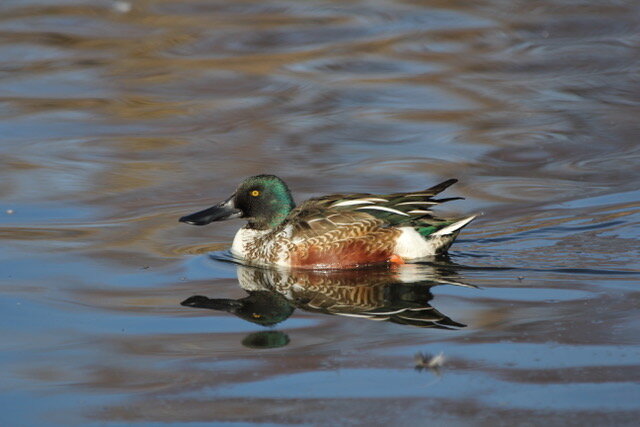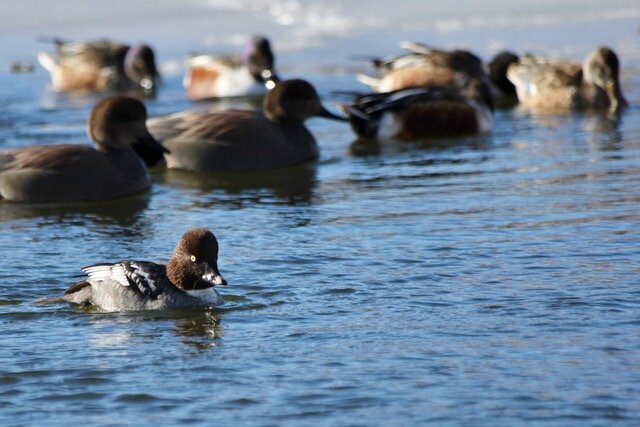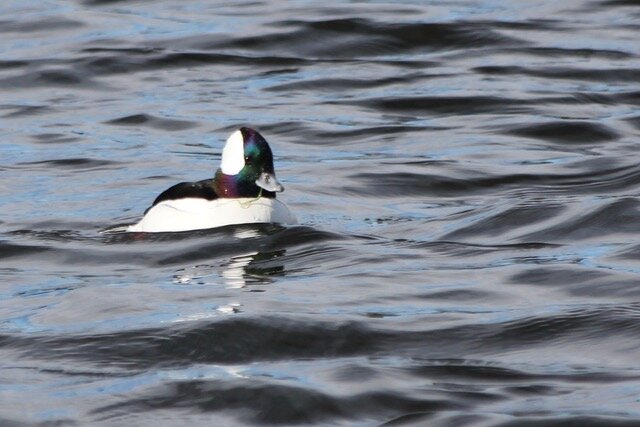Flirting in full swing on Grasmere Lake
Ducks expected to pair up in Denver before leaving for Canada this spring
Special to Colorado Community Media - This story was originally published in Washington Park Profile/Life on Capitol Hill, a publication of Colorado Community Media.
Despite the cold temperatures, a hot singles scene is developing in the middle of Washington Park’s Grasmere Lake. Many species of wild ducks have arrived in Colorado from points north — and they are not about to let their gorgeous new breeding plumage go to waste.
Striking color combinations of emerald, purple, chestnut and contrasting black and white abound. And colorful plumage is just one tool in the male duck’s courtship arsenal. During the winter months, spectators can see all kinds of impress- the-ladies posturing, from short fly-overs to waterski landings.
If you’re not personally attracted by head-pumping and wing flapping, clearly you are not a female bufflehead, common goldeneye or northern shoveler — three species that are currently flirting in and around Washington Park.
Tiny black and white buffleheads thrust their chests out while skiing across the water of Grasmere Lake. Northern shovelers — resplendent with iridescent green heads, chestnut flanks and splashes of green and white around the tail — rear up from the water like stallions. Male common goldeneyes, with amber eyes, black plumage and stylish white markings, specialize in acrobatics. In an extraordinary move called the head throw kick, the male goldeneye bends his head so far back it nearly touches his tail feathers, then whips it forward and churns up the water with his feet. Now what lady wouldn’t fall for that?
It is pretty easy to fall for little buffleheads, who resemble rubber duckies with their oversized heads and petite bodies. For shore spectators, buffleheads are the stand-up comics of waterfowl. Even when not flirting, they perform astonishing dives, bobbing along, then vanishing with an abrupt vertical plunge. Ten to 30 seconds later, they pop back up like corks. Their short bills curve upward in a perpetual smile. They seem to know they’re putting on a show.
According to the Cornell Ornithology Lab, these little black and white ducks are an ancient species, dating back to the late Pleistocene some 500,000 years ago. While “buffle” refers to the oversized heads of buffalo, the name itself is an archaic insult. In the 1600s, being called a ‘bufflehead’ meant something akin to bonehead, chowderhead or nincompoop. But maybe the term should be revived as a compliment, referring to someone who is not only funny but resilient, like a cork that keeps popping back to the surface.
When our duck visitors aren’t wooing, snoozing or preening their feathers, the are usually feeding. Common goldeneyes and buffleheads are adept divers and predators, devouring snails, crawdads and small fish while still underwater. Northern shovelers are dabbling ducks as opposed to divers. According to the Cornell Ornithology Lab, they often cruise marshy areas, swinging their spoon-shaped bills from side to side, filtering the water in search of insects, seeds and tiny crustaceans.
The Boreal Songbird Initiative, which is a Canadian conservation group, notes that northern shovelers have highly specialized tongues “with extensive comb-like teeth called lamellae, which help filter food items from the water.”
Buffleheads, common goldeneyes and northern shovelers are just a few of the wild duck species who winter in Colorado. According to Denver Audubon Master Birder Mary Keithler, other striking winter visitors include male redheads with vibrant auburn heads and necks; and hooded mergansers who sport tall, semicircular white crests trimmed with black. Other visiting species include American widgeons, gadwalls, green-winged teal, pintails, ruddy ducks, greater and lesser scaup, and occasionally, scoters and long-tailed ducks. The females generally dress in subdued browns and grays, which helps them evade predators while they brood on their eggs. But males can almost always be counted on to put on the dog.
Many of our visiting ducks will pair up sometime between December and March. As spring takes hold, they will begin to leave for Canada and other points north. There, the buffleheads and common goldeneyes will nest in tree hollows, while mama northern shovelers will create cozy hollows lined with down among the shore grasses.
Right now, those progeny are just a twinkle in the eyes of their prospective parents — but next winter, we can expect them back in Colorado where it all began.


